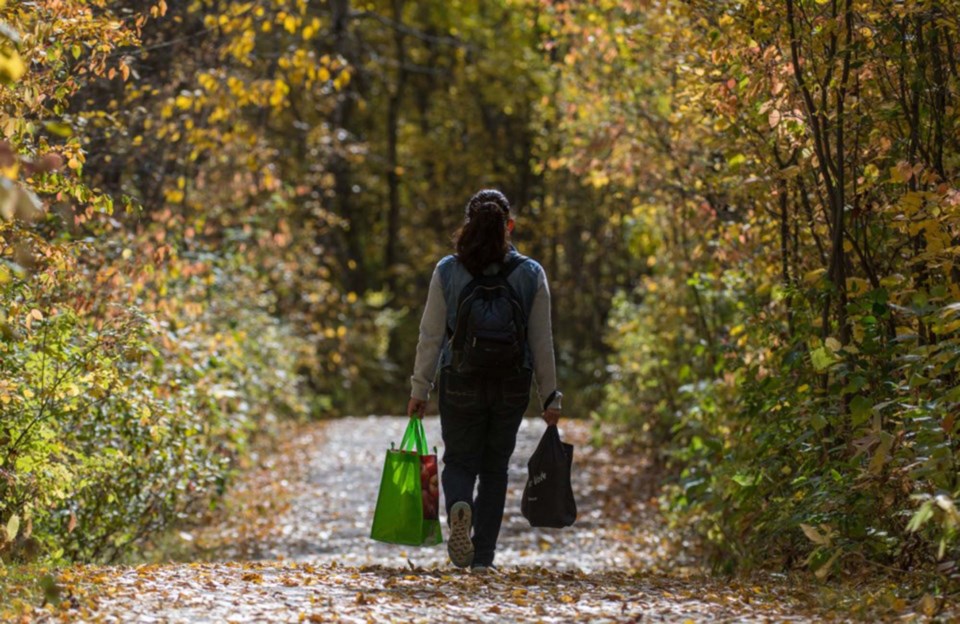Smaller communities might argue they already have 15-minute communities, where shopping entertainment, health, and educational services are a walkable distance away, but there is at least one aspect that makes the 15-minute community concept more difficult for smaller communities to fully implement.
Sandeep Agrawal, a professor and director at the School of Urban and Regional Planning at the University of Alberta, said smaller cities that have lower densities like Red Deer, Airdrie or St. Albert might have issues in creating employment for their citizens within that 15-minute frame.
“In many of these small cities, employment is not concentrated at one place or even in that city. People travel large distances for work. So, that will then defeat the whole purpose because most of the traveling is happening for a long time,” he said.
The 15-minute city is based on the concept that each community can have all the daily amenities and services within a 15-minute walking or biking distance.
The plan is meant offer citizens a better quality of life and a more environmentally sustainable city.
Nicole Lynch, communication advisor for the City of St. Albert said to the city, the 15-minute city concept is about giving residents access to most of their daily needs within 15 minutes of their home through walking, biking or public transit.
“Due to its size and layout, St. Albert already provides the opportunity for people to live, work, and play within their community,” she said in an email.
Lynch said the city wants people to have accesses to whatever they need in the community, while also “being a community that thrives as a part of greater Edmonton region.”
Jill Iverson, communicatios spokesperson for the City of Airdrie, said in an email that citizens have been asking if the Smart City proposal of 2017 was linked to the 15-minute city.
“The goal of our Smart Cities proposal was very different from 15-minute cities concepts,” she said adding that the Smart Cities proposal was dropped after Airdrie was not chosen to receive grant funding.
“The City of Airdrie doesn’t currently have 15-minute cities on our radar at all and it’s not in our strategic plans,” she continued.
Sara Alaric from the City of Red Deer said there are no upcoming or proposed planning or design guideline changes for neighbourhood designs.
“Our neighbourhoods are always designed with connectivity in mind,” Alaric said in an email.
Agrawal said there is certainly interest in making small communities, cities, towns more sustainable. And there are benefits in trying to implement changes in a smaller community.
“Pros are that there are fewer people there could be better consultation…On the other hand, if people don't agree then you can galvanize very quickly against the concept,” he said.
Smaller communities that want to become more sustainable should densify, said Agrawal, like Strathcona County which has put zoning regulations in place to concentrate housing.
“So (houses are) not spread out all over because that's what leads to more roads this and that and leads to more sprawl. Those things are happening. It will take some time to realize the idea,” he said.
Buildings and transportation are the two main culprits of greenhouse gas emissions, and 15-minute city plans could help combat those emissions.
“If you reduce transportation, people travelling large distances then this will certainly help in creating more sustainable communities,” said Agrawal.
When it comes to buildings, a low-density area with single-family homes tend to make more greenhouse gas emissions than a multi-unit building, townhouse, or apartment building, he said.
Edmonton Mayor, Amarjeet Sohi campaigned on making the 15-minute city a reality in Edmonton, during the 2021 municipal election and the concept of a more walkable city was a part of the city plan which was approved by Edmonton City Council in December of 2020.
The term 15-minute city was originally coined in 2016 by Carlos Moreno, a professor at the University of Paris. Moreno won the international architecture award, the Obel Award, for the “new urban model” in 2021, according to the Obel Foundations website.
The concept of a 15-minute city is not new, said Agrawal, and is not that different from concepts such as institutionally complete communities, snare growth, or complete communities.
“I think it's a bit of a catchy phrase and perhaps resonates better the common people. And the flip side of it is that as we know what is going on, people think that they will be locked into these 15-minute distances,” he said.
Recently, the 15-minute plan has been a hot conspiracy topic on social media, and on Feb. 10, a group of around 30 people gathered at a Whyte Avenue intersection to protest against the concept. A sign for the protest claimed 15-minute cities would limit an individual’s movement between districts.
“You will spend 90 per cent of your life in this 15-minute area as they are monitoring your “carbon footprint” aka your actual footprint,” a social media post with a fact check warning states.
Agrawal said he was surprised by the conspiracies floating around.
“But I’m a planner,” he said. “…If you look the Canadian Constitution, very clearly, says that every Canadian has guaranteed freedom of mobility to anywhere within the country. This whole idea that we'll be somehow locked in is totally ludicrous idea.”
Agrawal said it will take at least a decade for Edmonton to make a transition to becoming a 15-minute city and will require new zoning regulations that allow higher density a mixed use, as well as better transit and connectivity between communities
“I think it's aspirational at this point of time. Proof of the pudding will be how it will be done, how it will be implemented. It has to start from somewhere, but it will take some time,” he said.



